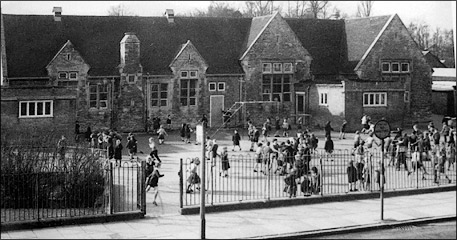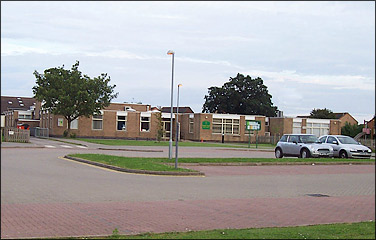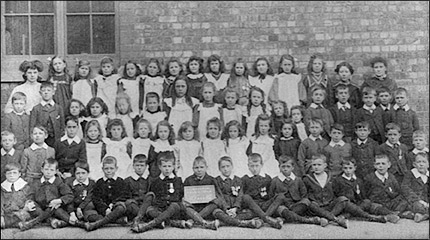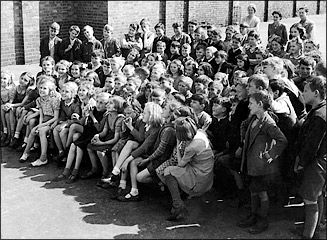|
The Select Committee on Education of the Poor 1818
reported that there was no provision in the village, but
"a Sunday school, supported by voluntary subscriptions, at which between 60 and 70 children are instructed, and one held at a meeting house containing nearly the same number".
The poorer classes have not sufficient means of educating their children, and are desirous of possessing them.
|
Abstract of Education Returns 1833 - Rushden (Population1,245)
Two Infant Schools, containing 32 children of both sexes; and
One Daily School, 26 males and 4 females; all of whom are instructed at the expense of their parents.
Two Sunday Schools, supported by subscription; whereof one, of the Established Church, is attended by 57 males and 44 females; the other is connected with the Baptists, and consists of 60 males and 80 females.
|
|
Both the Baptists and the Church of England started schools in the early 1800’s. About 1850, Ebenezer Knight, a Baptist, was the master of a small day school held in the old workhouse in the grounds of St Mary’s Church. In 1869 there was also an infant class with Mrs. Margaret Wagstaff as mistress.
When Mr Frederick Sartoris at Rushden Hall gave land for a day school, South End was built in 1870. It opened on April 25th 1870 with 146 children, mostly infants. There were several small private schools in the town, but the
National
School
was for the children of the working classes, and could accommodate 250 children. The Reverend Barker (C of E) was a frequent visitor to the school, as were the members of the Sartoris Family, and Mrs Currie from Rushden House would help to teach the girls.
National Schools
These were - in essence - Anglican Church Schools. The National Society was founded in October 1811. At the founding meeting, a statement about educational purpose was recorded: "That the National Religion should be made the foundation of National Education, and should be the first and chief thing taught to the poor, according to the excellent Liturgy and Catechism provided by our Church."
The Society was strongly involved in many aspects of education, including publishing books, providing equipment, and training teachers.
The Society's mission was to found a Church school in every parish in England and Wales. It was involved with the foundation of the majority of Church of England schools, which were originally known as National Schools.
Board Schools
The Education Act of 1870 allowed for schools to be under the control of locally elected School Boards. The Act stated that any area which voted for it could have a School Board. These new Board Schools could charge fees but they were also eligible for government grants and could also be paid for out of local government rates.
Boards provided an education for the five to ten age group. In some areas Board School boards pioneered new educational ideas. For example, the London School Board introduced separate classrooms for each age group, a central hall for whole-school activities and specialist rooms for practical activities.
|
| School board formed 1877 - 5 members |
|
| Chairman |
Mr. Samuel Knight |
|
| Vice-chairman |
Mr. W. H. Wilkins |
|
|
Mr. G. Denton |
The Board was increased to:- |
|
Mr. N. Crick |
7 members in 1889
|
|
Mr. J Claridge, jun. |
9 members in 1898
|
| clerk |
Mr. Sharman, Wellingborough |
|
| Master |
Mr. Walter Wood, Halford Street, W'boro |
|
| Mistress |
Mrs. Wood |
In 1903 James Heygate was clerk |
| Attendance Officer |
Mr. William Packwood, Grove Villa |
Attendance Officer was George Bayes |
|
The nonconformists tried to establish a
Board
School
and failed, so they established a school in the Temperance Hall. The log book for the National School states on Wednesday April 3rd 1872: ‘Heard this morning that the Dissenters intend opening a school next Monday in opposition to this one’. George Hustwaite was the master of this new school and about 20 children left the National to attend there. It was called the General School and later became the Board School, when the Alfred Street schools were built.
In 1877 the question of a
Board
School
was again raised and at the meeting called in the vestry hall there were over 500 people present. By this time the shoe trade was rapidly expanding; machinery was making factory work more necessary and the main manufacturers were nonconformist in their beliefs. Those employed in the factories wanted to vote with their employers, who had given them higher standards of living, and so the vote was won. The case for the Board School was still a fight – they conducted a census of school-aged children to prove there was a need for another school. Their original plan for
Alfred
Street
Board
School
was reduced in scale to appease its critics, and was finally opened in 1879.
Expansion of numbers, through the influx of workers for the shoe trade, brought another infant school in
Moor Road
in 1889, and then another in
Newton Road
came in 1894 and was also a Board School.
Moor Road
was closed in 1912.
In the 20th century, the Councils eventually took over all the education establishments: Alfred Street Infant School (later transferred to a new Hayway Infant School), the mixed school became the Junior School, Newton Road had both Infant and Junior (formerly mixed), South End was a Primary school and Tennyson Road Infant school opened. At Hayway there was another school for older children called the
Intermediate
School
.
It is sometimes forgotten that, for the first half of the 20th century, girls did not enjoy the same educational opportunities as boys during their teen years. While boys would be assisted into things like apprenticeships, marriage was still thought to be the prime career for girls. Listen to Connie Hobson talking about how she encountered this in about 1918.
To see the control panel in Internet Explorer, you may have to click
on the yellow bar at the top of the screen and "allow blocked content"
In 1965 a new school was built in
Wymington Road
to replace the Old South End, and then in 1973 a new wing was built for infants, with the juniors taking over the whole of original building on the site. Also in 1973,
Whitefriars
School
was built.
The Intermediate was later titled as a ‘Secondary Modern’ and then became girls only when a new school for boys was built in the 1950’s at
Tennyson Road
, later renamed
Pemberton
School. North End School was built on a site at the end of Spencer Road for the girls, and then in 1971 when 'Comprehensive' schools were formed, the Boys and Girls senior schools were amalgamated as ‘Chichele’ school and the site of North End School was greatly enlarged. The
Pemberton
School
was demolished and the site sold off to pay for the expansion.
|
|
|
Two photos of children at Newton Road School
Left - a photo of "Class VII" - date unknown, probably sometime around 1900. Right - a photo from 1948.
|
|



